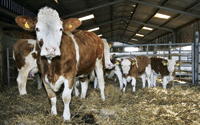Budgets can help manage volatile markets

Increasing volatility in agricultural markets means it is more important than ever livestock farmers devote time to accurate financial planning.
That is the advice from Lloyds TSB agriculture’s Dick Mason, ahead of this year’s AgriLIVE Smithfield show (see panel). The welcome return to profitability across much of the red meat sector is encouraging some farmers to reinvest and expand their business, but he says anyone doing so must think plans through carefully.
“Volatility is definitely here to stay and developing any business becomes a lot more complicated in times when it’s so challenging to predict the future, which makes financial planning more, not less, important.”
Budgets
Producing a realistic budget is one of the main steps in this planning process, Mr Mason says. “It’s best to budget for at least the next two years and base the assumptions on average returns over the past three years at least, rather than using spot prices. Be realistic, not overly pessimistic or optimistic,” he says.
Farmers should also provide their bank with a clear outline of any assumptions behind the budget, he notes. “Too often we just receive a page of figures, but we need to know what they’re based on. It’s all about building a relationship and giving us the confidence that you, as a businessman, are in control.”
Budgets should be kept as working documents that farmers and bankers can go back to as things change, he continues. “Too often people complete a budget, and then file it away. But you need the budget as a benchmark to show how rises or falls in prices impact on your business – it can often help in discussions with the bank manager.”
Budgets should include an element of sensitivity analysis that shows the possible impact of a rise or fall in output prices or costs. “It’s also worth including a contingency to cover unexpected costs. In the case of overheads, this should be at least 5%,” he says.
Cashflow
Alongside the budget, a cashflow forecast is an often overlooked tool that can highlight pinch points in the farm’s cash requirements, Mr Mason says. “A lot of people underestimate how much cash can be soaked up when expanding a livestock business, especially for valuation increases.”
Working capital requirements are often “grossly underestimated” when livestock farmers are expanding, so paying extra attention to factors such as stock valuations, fattening periods and extra feed costs is worthwhile.
“Another common problem with many cashflow forecasts is that people are too optimistic on the timing of income. Be realistic about when you’re likely to get paid and consider what happens if there’s a delay.”
He also advises farmers not to be overoptimistic about their ability to repay borrowed capital. “Spreading debt over a longer period can ease the pressure on cashflow, or alternatively you could consider interest only options for the first year or two.”
Before investing in any new facilities, he says it is worth ensuring you are getting the most out of the existing system. “Expand to the limit first, then invest in extra capacity, as it’ll also help provide a bit extra income to service any new debt.
Managing risk
Risk management is increasingly important as markets become less predictable and Mr Mason says forward contracts are vital. “Even if 50% of what you produce is contracted, it will give you more security and certainty when planning. You might not maximise income, but you will reduce the risk.”
The same applies to interest rates, he says. “At the moment both variable and fixed rates are low by historical standards, but any business looking to expand should consider fixing some of that debt for the longer-term, as well as taking advantage of the currently low variable rates.
“We expect base rate to remain where it is [0.5%] until the middle of next year, when we could see a quarter of percent rise. Any rise over the next couple of years should be gradual. Predicting beyond that is very difficult, which is why it’s worth locking into some of the low rates available now.”
Overall, Mr Mason says livestock producers should make the most of the return to profitability by investing in stock, improving efficiency or reducing debt, but be wary that things can quickly change. “Don’t waste the current opportunity. We all have to accept that a bad year may be around the corner, but action now can put you in a better situation to deal with it.”
Find out more
AgriLIVE Smithfield is a new technical event for the red meat supply chain, designed to help producers maximise the efficiency of livestock production. The free two-day event will feature the latest products, business advice, workshops, forums and debates. It also incorporates the prestigious Smithfield primestock classes.
Visit AgriLIVE Smithfield on 11 and 12 December at Stoneleigh Park, Warwickshire. For more information go to www.agrilivesmithfield.co.uk
